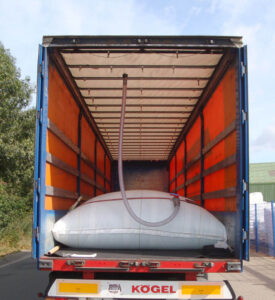The most common method to transporting bulk liquids is a ISO standards tank container, but flexible tanks are an alternative solution. flexible tanks are standard intermodal containers with a bladder or bag for transporting and storing non-regulated liquids. With the bladder inside the 20′ containers and filled, fluids are protected from moving and punctures. Because a bulkhead fixture is used at the open end of the container, the bladder is supported from expanding outside of the container. Sizes range from 16,000 to 26,000 liters and can top-loaded or loaded from the bottom.

Source: Wikipedia
The internal bladder is suitable for food-grade liquids and nonhazardous liquids such as base oils, beer, wine, molasses, glycerine, fruit juices, latex, egg products, water, oils, bio-diesel, edible oils, wine, non-hazardous pharmaceuticals, chemicals, and even some dry cargo. The materials used in the production of flexi-bags (bladders) meet the United States Food and Drug Administration, ISO 9001:2008 compliant. The bladder also protects liquid from ambient air, therefore reducing oxidation.
Containers are commonly lined with corrugated cardboard or protective membrane to prevent bladder punctures. Containers can have temperature control heating elements, aseptic filling, agitation for high-density products, ventilation.

Flexi bags can cost 50-80% less than traditional liquid containers like drums and ISO tanks, but are considered less environmentally friendly. Because about 5% of the liquid is left in the container, something that doesn’t happen with tank containers, flexible tanks may not make sense for expensive bulk liquids.

 ISO Tank, Tank Container, ISOtainers, Seatainer, Intermodal Container
ISO Tank, Tank Container, ISOtainers, Seatainer, Intermodal Container
ISO Tank, also known as ISOtainers or intermodal containers are built to ISO (International Organization for Standardization) standards and used to transport bulk cargo. Suitable for a variety of transportation modes such as truck, ship, and rail, the hazardous and non-hazardous products transported in these stainless steel shipping containers are often insulated by layers of polyurethane and aluminum within the container. Standardization in size and shape allows for the structural integrity required for moving using heavy equipment and ensures the container will withstand harsh environmental conditions during transport.




















 ISO Tank, Tank Container, ISOtainers, Seatainer, Intermodal Container
ISO Tank, Tank Container, ISOtainers, Seatainer, Intermodal Container



